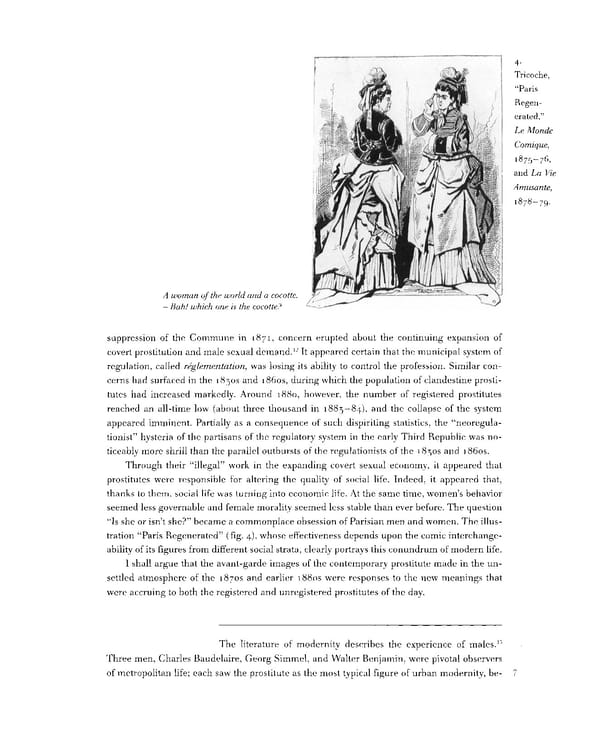4- Tricoche, "Paris Regen- erated," Le Monde Comique, 1875-76, and La Vie Amusante, 1878-79. A woman of the world and a cocotte. — Bah! which one is the cocotte? suppression of the Commune in 1871, concern erupted about the continuing expansion of 12 covert prostitution and male sexual demand. It appeared certain that the municipal system of regulation, called reglementation, was losing its ability to control the profession. Similar con- cerns had surfaced in the 18305 and i86os, during which the population of clandestine prosti- tutes had increased markedly. Around 1880, however, the number of registered prostitutes reached an all-time low (about three thousand in 1883 — 84), and the collapse of the system appeared imminent. Partially as a consequence of such dispiriting statistics, the "neoregula- tionist" hysteria of the partisans of the regulatory system in the early Third Republic was no- ticeably more shrill than the parallel outbursts of the regulationists of the 18308 and i86os. Through their "illegal" work in the expanding covert sexual economy, it appeared that prostitutes were responsible for altering the quality of social life. Indeed, it appeared that, thanks to them, social life was turning into economic life. At the same time, women's behavior seemed less governable and female morality seemed less stable than ever before. The question "Is she or isn't she?" became a commonplace obsession of Parisian men and women. The illus- tration "Paris Regenerated" (fig. 4), whose effectiveness depends upon the comic interchange- ability of its figures from different social strata, clearly portrays this conundrum of modern life. I shall argue that the avant-garde images of the contemporary prostitute made in the un- settled atmosphere of the 18705 and earlier i88os were responses to the new meanings that were accruing to both the registered and unregistered prostitutes of the day. The literature of modernity describes the experience of males.15 Three men, Charles Raudelaire, Georg Simmel, and Walter Renjamin, were pivotal observers of metropolitan life; each saw the prostitute as the most typical figure of urban modernity, be- 7
 Prostitution & Impressionists Page 27 Page 29
Prostitution & Impressionists Page 27 Page 29